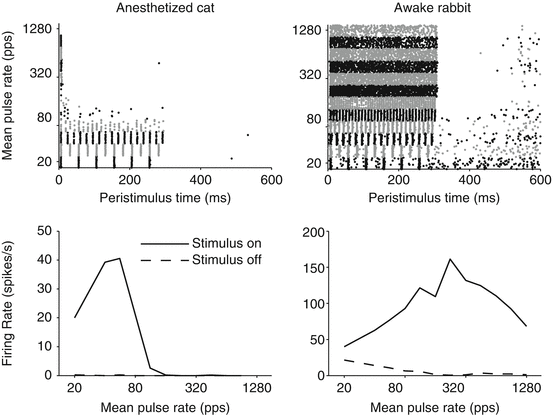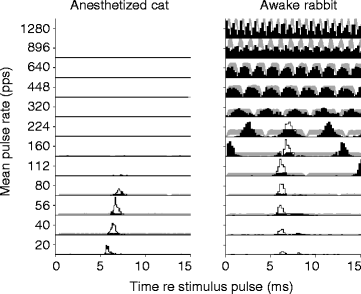Psychophysical: human CI subjects
Neural: IC neurons in anesthetized cats
Percept lasts throughout stimulus
>2,000 pps
30–300 ppsa
Sustained responses
Rate pitch discrimination
200–1,000 ppsb
40–200 ppsa
Temporal coding
ITD sensitivity
250–600 ppsc
10–200 ppsd
ITD sensitivity
We hypothesize that neural pulse-locking, ITD sensitivity, and sustained firing to CI stimulation at high pulse rates may be underestimated due to the effect of anesthesia. We developed an awake animal model of CIs for single-unit recording from the IC to avoid this confound. Results show higher pulse-rate limits for sustained firing and temporal pulse-locking compared to anesthetized preparations. We further demonstrate that these differences are due to the effect of anesthesia by monitoring the responses of single units in the rabbit before and after injection of an ultrashort-acting barbiturate.
2 Methods
We measured responses of IC neurons to electric pulse trains presented through 8-contact intracochlear electrode arrays (Cochlear Corp.) in both anesthetized cats and awake rabbits. Experiments on awake rabbits were performed on two female Dutch-belted rabbits that received unilateral cochlear implantations. The implanted ear was deafened during surgery with an injection of distilled water into the cochlea (Ebert et al. 2004). Although no attempt was made to deafen the unimplanted ear, auditory brainstem response thresholds were nevertheless elevated by 40–50 dB relative to normal in that ear. Rabbits were implanted with head bars and trained to sit still in the recording apparatus for 2–3 h/day. Recordings from the IC contralateral to the implanted ear were performed from 29 to 431 days postimplantation.
For comparison with the awake rabbit data, we reanalyzed data from anesthetized cats that were partially described in earlier reports (Hancock et al. 2010, 2012). These experiments were performed on eight cats deafened with ototoxic drugs either 1 week (n = 3) or 6 months (n = 3) before the experiment and which received bilateral cochlear implants at the time of experiment. For the experiments, cats were anesthetized with a combination of urethane (300 mg/kg urethane, i.p.) and either diallyl barbituric acid (75 mg/kg, i.p.) or sodium pentobarbital (37 mg/kg, i.p.). Data from both short-term (1 week) and long-term (6 months) deafened cats are combined herein because the differences in response patterns between the two groups were minimal.
In both preparations, stimuli were 300-ms trains of biphasic pulses (50 μs/phase) presented every 600 ms using a wide bipolar configuration. The current was 2 dB above the single-pulse threshold, and the stimuli were presented diotically in anesthetized cats and monaurally in awake rabbits. Pulse rate was varied in random order from 20 to 1,280 pps in half-octave steps. The single-unit recording methods were as described previously (Devore and Delgutte 2010; Hancock et al. 2010).
In one rabbit, a catheter was surgically implanted into the right jugular vein to allow the administration of an ultrashort-acting barbiturate (sodium methohexital, 5 mg/kg) while recording from single units (Kuwada et al. 1989). All procedures were approved by the animal care committees at the Massachusetts Eye and Ear Infirmary and the Massachusetts Institute of Technology.
3 Results
3.1 Pulse-Rate Limits Are Higher in Awake Rabbits Compared to Anesthetized Cats
Responses to electric pulse trains were measured as a function of pulse rate in 104 units in anesthetized cats and 80 units in awake rabbits. We observed clearly different response patterns in the two preparations. Results from two example units are presented in Fig 39.1. In the neuron from anesthetized cat, there is a strong pulse-locked response at low pulse rates indicated by the periodic pattern in the dot raster. The unit fires one spike per pulse at 20 and 40 pps, but the firing rate begins to decrease at higher pulse rates until the response is limited to the onset for pulse rates >80 pps. There is no spontaneous activity either during the off period or between pulses at low pulse rates. In contrast, the neuron from an awake rabbit fires several spikes per pulse at low pulse rates (i.e., the firing rate is greater than the pulse rate) and the responses are pulse-locked up to higher pulse rates than in the neuron from anesthetized cat. Sustained responses are maintained up to the highest pulse rate tested (1,280 pps). In addition, spontaneous activity is observed both during the off period and between pulse-locked responses at low pulse rates.


Fig. 39.1
Temporal response pattern (top) and average firing rates (bottom) as a function of pulse rate for two example neurons in anesthetized cat (left) and awake rabbit (right). Top panels show dot rasters, where each dot represents a spike and alternating shades of gray distinguish blocks of stimulus trials at different pulse rates. Bottom panels represent mean sustained firing rate (excluding the first ∼30 ms after stimulus onset) vs. pulse rate
Neural spike trains were cross-correlated with stimulus pulse trains to characterize the degree of temporal pulse-locking. The cross-correlograms in Fig. 39.2 are consistent with the temporal patterns shown for the same neurons in Fig. 39.1. Robust pulse-locking is evoked by low-rate pulse trains in both neurons, as shown by a prominent peak in the cross-correlogram. In the neuron from anesthetized cat, pulse-locked responses vanish above 80 pps, consistent with the limit of sustained firing. In the neuron from awake rabbit, tight pulse-locking is observed up to 224 pps. The correlogram shows multiple peaks for rates between 80 and 224 pps, reflecting the periodicity of the stimulus. Above 224 pps, the responses become unsynchronized, as indicated by the absence of cross-correlogram peaks exceeding the 99 % confidence bound for a random spike train.


Fig. 39.2




Cross-correlograms between neural spike trains and stimulus pulse trains for the same two example neurons as in Fig. 39.1. Gray shading indicates 99 % confidence bounds; correlation peaks exceeding the confidence bounds are filled in white
Stay updated, free articles. Join our Telegram channel

Full access? Get Clinical Tree


